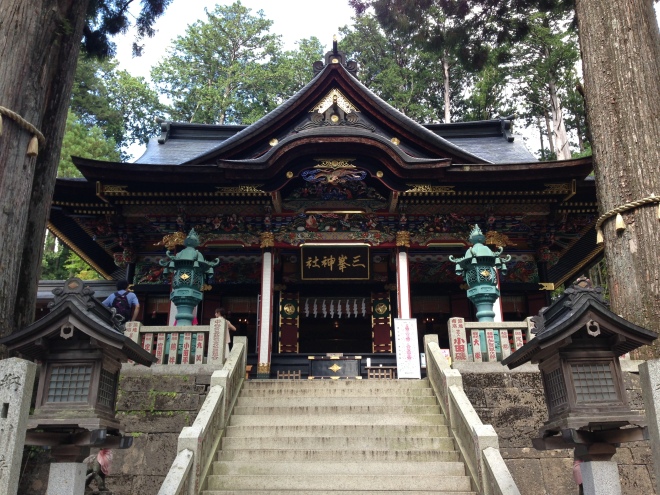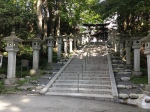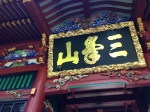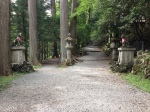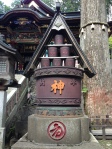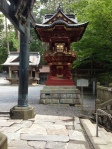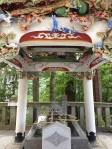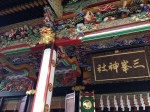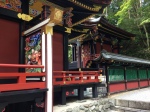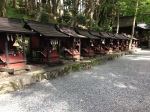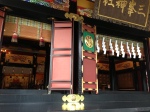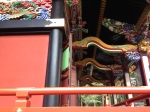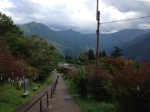Take a day to leave the bustling city of Tokyo behind and grab a Seibu line express to head up to Chichibu in northern Saitama prefecture in order to take in the sights. The mountain slopes, the countryside, the hot springs, the… shrine famous for wolf worship?
Welcome to Mitsumine Jinja, a shrine built in the forests of Mount Mitsumine about three hours out from Tokyo proper.
Though not the easiest shrine to get to, Mitsumine Shrine is well worth the day trip you need to set time and money aside for. About 90 minutes by Seibu express and then a further hour plus ride by bus will take you to this out of the way worship site situated near the top of a mountain in the Chichibu Tama National Park. The views from the top are breathtaking from any angle, and make great photographs for those inclined.
Established as a site of worship over 1,900 years ago, around 110 A.D, Mitsumine Shrine’s history states that as the then still mortal Yamato Takeru was returning home from battles with enemies in the east he stopped on the road and was captivated by the view from mountain. Fond of the view of the three other mountains from the summit, he dubbed it Mitsumine, (three peaks), and established a shrine there before continuing on his journey. The site of the buildings and the layout has been changed since then, but the history itself is ancient even if the architecture isn’t.
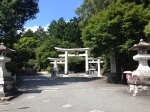 After your long bus ride up the winding roads of Mount Mitsumine, stretch your legs before heading up the last bit towards the shrine. You’ll be greeted by a shining white torii gate with a rare triple entrance, flanked by statues of wolves that have made Mitsumine famous. You will see little of the lion dogs, (koma-inu), and foxes, (kitsune), here. The familiars, (kamitsukai), those who bring messages and relay things to the gods of Mitsumine are these wolves, though the Japanese wolf has been extinct since the very early years of the 20th century.
After your long bus ride up the winding roads of Mount Mitsumine, stretch your legs before heading up the last bit towards the shrine. You’ll be greeted by a shining white torii gate with a rare triple entrance, flanked by statues of wolves that have made Mitsumine famous. You will see little of the lion dogs, (koma-inu), and foxes, (kitsune), here. The familiars, (kamitsukai), those who bring messages and relay things to the gods of Mitsumine are these wolves, though the Japanese wolf has been extinct since the very early years of the 20th century.
Continuing past the gate up the path lined with monument stones and lanterns, you will come to a crossway. One path to the right leads to a scenic viewing spot out over the mountain view, as well as has a hiking path which leads you to the okumiya at the summit of the mountain. Unfortunately I didn’t have time to hike up when I went, as it can take up to an hour each way, but if you have the time, then by all means!
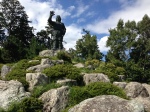 If you continue straight towards the figure you should be able to see rising over the trees, you’ll arrive at the statue of Yamato Takeru commemorating the divinity that founded the shrine so long ago. I have to admit that for those in the business of taking funny photos, you’ll have fun with this one.
If you continue straight towards the figure you should be able to see rising over the trees, you’ll arrive at the statue of Yamato Takeru commemorating the divinity that founded the shrine so long ago. I have to admit that for those in the business of taking funny photos, you’ll have fun with this one.
To the left is the beautiful Zuishinmon gate, with the traditional stone marker for the shrine placed in front and guarded once more by stone wolves. Despite how they may look, most of the wolves aren’t terribly ancient as far as shrine paraphernalia goes. Because this shrine is associated with prayers to prevent fire and burglary, Mitsumine became a very popular pilgrimage spot in the Edo period as multiple large fires tore through Tokyo (then Edo), and thieves finished off the abandoned homes. Most of the wolf statues at the gates and along the paths were commissioned by parishioners from around this time.
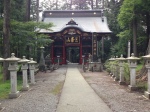 On through the gate towards the main hall you may also see a decommissioned torii gate in the woods on your way with a rope across it to prevent passing through. Centuries ago Chichibu’s logging industry boomed as Edo did, shipping hewn logs down the river to the growing capitol. During that time the first shrine was down closer to the logging area, and this area was considered the inner shrine until the sight was shut down, at which point this hall become the lower hall instead, rendering the gate marking it as an inner shrine as incorrect, though it was not torn down, only roped off.
On through the gate towards the main hall you may also see a decommissioned torii gate in the woods on your way with a rope across it to prevent passing through. Centuries ago Chichibu’s logging industry boomed as Edo did, shipping hewn logs down the river to the growing capitol. During that time the first shrine was down closer to the logging area, and this area was considered the inner shrine until the sight was shut down, at which point this hall become the lower hall instead, rendering the gate marking it as an inner shrine as incorrect, though it was not torn down, only roped off.
Continue on the path and you will finally arrive at the main hall of Mitsumine Shrine. At the very top of the stairs is the fountain for purification, covered in absolutely gorgeous lacquered wood carvings with a dragon theme. To the right, a fairly new and fairly large bronze lantern. In front of you is the hall itself, flanked by sacred trees on either side.
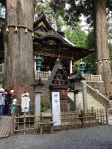 Over two hundred years old, with an inner sanctuary within it over three hundred and fifty, the main hall itself is a lovely piece of work in dark woods with colorful lacquer work depictions of various fauna real and mythological as well as flora and human characters from various legends. Make sure to look closely at the whole circumference or risk missing out on something beautiful! It’s dedicated to Izanami and Izanagi, the parent gods of the Japanese pantheon, so for those seeking to become a couple it may be just right!
Over two hundred years old, with an inner sanctuary within it over three hundred and fifty, the main hall itself is a lovely piece of work in dark woods with colorful lacquer work depictions of various fauna real and mythological as well as flora and human characters from various legends. Make sure to look closely at the whole circumference or risk missing out on something beautiful! It’s dedicated to Izanami and Izanagi, the parent gods of the Japanese pantheon, so for those seeking to become a couple it may be just right!
To the right of the main hall you can find some subsidiary shrines to various other deities worshipped around the country, particularly those that have old ties to Mitsumine Shrine. It’s here in this inconspicuous place that you will find the oldest artifact on the shrine property- the subsidiary shrine to the defied Tokugawa Shogun worshipped at Toshōgu in Nikko. The wood used to construct this small shrine dates all the way back to the Muromachi Period, or the 15th/16th century.
To the left of the main hall you can find the shrine offices and reception for services and charms. The most original of the bunch is Mitsumine’s “ki” omamori, recommended for those seeking motivation of some kind. For those looking to relax after a long day or even stay the night, there’s actually a hot springs hotel connected to the shrine office! Fore less than ten dollars you can use only the hot springs services as well, you needn’t commit to a room.
But don’t stop there! The lure of onsen may be strong, but soldier on past the hotel and parking, and follow the signs to the Enmusubi Trees and the shrine to Okuchi no Makami, the wolf god whose rarity has made this shrine all the more of a standout. The Emusubi Trees are two pines grown against each other that are said to bring fortune to those seeking a good match. (When I went, someone had even left their panties behind tied off to the fortune racks… !)
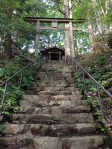 Just beyond the trees is the wolf god’s shrine, up some steep stone stairs to the simple wooden lean-to sheltering wolf statues and the alter. The simple but haunting structure is guarded by two rock formations on which carved stone wolves hunt, run and climb. Compared to the grandeur of the main hall this small shrine may seem inconsequential, but in the past many pilgrims came to this site just for this small shrine.
Just beyond the trees is the wolf god’s shrine, up some steep stone stairs to the simple wooden lean-to sheltering wolf statues and the alter. The simple but haunting structure is guarded by two rock formations on which carved stone wolves hunt, run and climb. Compared to the grandeur of the main hall this small shrine may seem inconsequential, but in the past many pilgrims came to this site just for this small shrine.
On your way back down to the bus stop you can always stop by one of the few shops and restaurants and get yourself a nice meal while you wait- though make sure of bus times beforehand, as depending on the day sometimes as few as four buses a day run on this route. Despite that inconvenience, the shrine itself is definitely worth going to, so I hope you decide to visit and enjoy it!
Access: Seibu Chichibu Station, Mitsumineguchi Station
Date of Founding: ~110 AD
Current Building Date: Main Hall, 1800’s, Inner Sanctuary, 1661
Enshrined God(s): Izanami no Mikoto, Izanagi no Mikoto
Special Point: Enmusubi, Protection from Fire and Burglary, Ki Mamori
Shrine Office: Y
Festival Dates: Setsubun Ritual (“Gomottomo-sama”) on Setsubun, (YouTube Video), Founding Festival on April 8th, and ritual offerings to the wolf god held monthly on the 10th and 19th, (“Otakiagesai”)
English Pamphlet: N
Goshuin: Y
Goshuinchou: Y
More Pictures:

